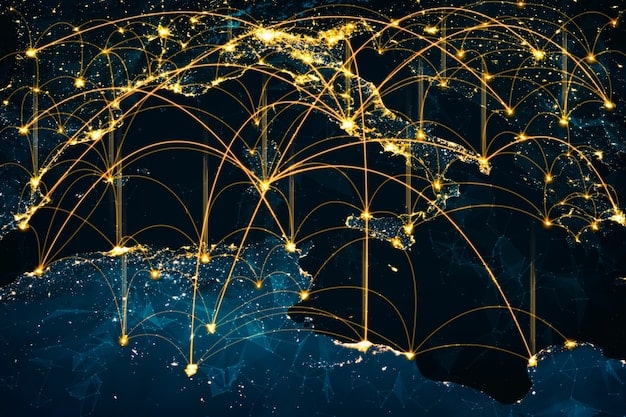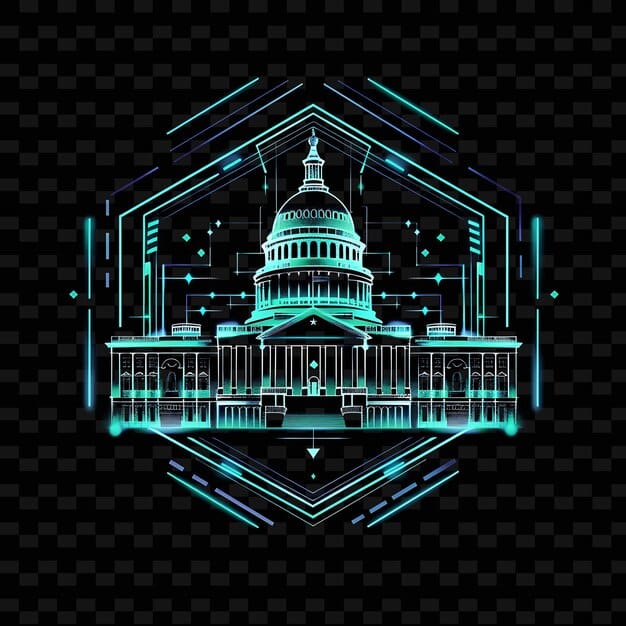US Cyber Defense: Addressing Critical Infrastructure Threats

The US is addressing the growing threat of cyberattacks on critical infrastructure through a multi-faceted approach involving enhanced cybersecurity regulations, public-private partnerships, increased funding for cybersecurity initiatives, and proactive threat intelligence sharing to safeguard essential services.
The United States faces an escalating challenge in protecting its critical infrastructure from increasingly sophisticated cyberattacks. From energy grids to water systems, these essential services are vulnerable to malicious actors seeking to disrupt, damage, or steal sensitive information. Understanding how is the US addressing the growing threat of cyberattacks on critical infrastructure is crucial for ensuring national security and economic stability.
Understanding the Cyber Threat Landscape
The cyber threat landscape is constantly evolving, with new vulnerabilities and attack vectors emerging regularly. Understanding the nature of these threats is the first step in developing effective defense strategies. Cyberattacks on critical infrastructure can have far-reaching consequences, impacting everything from public health and safety to economic stability.
Types of Cyber Threats
Critical infrastructure faces a variety of cyber threats, each with its own characteristics and potential impact. These threats can be broadly categorized based on the attacker’s motivation and the methods used to carry out the attack.
- Ransomware: Malicious software that encrypts data and demands a ransom payment for its release. Ransomware attacks can disrupt critical services and cause significant financial losses.
- Espionage: The act of secretly gathering information for competitive or strategic advantage. Espionage attacks can compromise sensitive data and undermine national security.
- Disruption: Attacks designed to disrupt or disable critical systems and networks. Disruption attacks can cause widespread chaos and economic damage.
- Destruction: Attacks aimed at permanently damaging or destroying critical infrastructure. Destructive attacks can have long-lasting consequences and require extensive recovery efforts.
Targeted Sectors
While all sectors of critical infrastructure are vulnerable to cyberattacks, some are more frequently targeted than others. These sectors often hold valuable data, control essential services, or have dependencies that make them attractive targets.
- Energy: Power grids, oil and gas pipelines, and other energy infrastructure are prime targets for cyberattacks. Disruptions to the energy sector can have cascading effects on other critical services.
- Water: Water treatment plants, dams, and other water infrastructure are increasingly vulnerable to cyberattacks. Compromising water systems can have severe public health consequences.
- Healthcare: Hospitals, clinics, and other healthcare providers hold sensitive patient data and control critical medical devices. Cyberattacks on the healthcare sector can compromise patient privacy and endanger lives.
- Financial Services: Banks, credit unions, and other financial institutions are frequent targets of cyberattacks seeking to steal money or disrupt financial transactions. Compromising financial systems can have significant economic consequences.
In conclusion, the complex nature of the cyber threat landscape requires a comprehensive and adaptive approach to cybersecurity. Understanding the types of threats and the targeted sectors is essential for developing effective defense strategies and mitigating the risks to critical infrastructure.
Legislative and Regulatory Frameworks
To address the growing threat of cyberattacks, the US government has established several legislative and regulatory frameworks. These frameworks aim to enhance cybersecurity practices, promote information sharing, and establish standards for critical infrastructure protection. These are vital components of how is the US addressing the growing threat of cyberattacks on critical infrastructure.
Key Legislation
Several key pieces of legislation have shaped the US approach to cybersecurity. These laws provide the legal basis for government agencies to protect critical infrastructure and respond to cyber incidents.
One example is the Cybersecurity Information Sharing Act (CISA), which encourages private sector companies to share cyber threat information with the government and each other. This information sharing helps to improve situational awareness and facilitate coordinated responses to cyberattacks.
Regulatory Bodies and Standards
Various regulatory bodies play a crucial role in overseeing cybersecurity within specific sectors of critical infrastructure. These agencies develop and enforce standards to ensure that critical infrastructure providers are implementing adequate cybersecurity measures.
- Cybersecurity and Infrastructure Security Agency (CISA): Leads the national effort to protect critical infrastructure from cyber and physical threats.
- National Institute of Standards and Technology (NIST): Develops cybersecurity standards and best practices for federal agencies and private sector companies.
- Sector-Specific Agencies: Agencies such as the Department of Energy (DOE) and the Environmental Protection Agency (EPA) have regulatory authority over cybersecurity within their respective sectors.
These regulatory bodies work to ensure that critical infrastructure providers are implementing robust cybersecurity measures and adhering to industry best practices. The standards developed by NIST, such as the Cybersecurity Framework, provide a comprehensive set of guidelines for managing cybersecurity risks.
In conclusion, the legislative and regulatory frameworks established by the US government provide a foundation for protecting critical infrastructure from cyberattacks. These frameworks promote information sharing, establish cybersecurity standards, and empower regulatory bodies to oversee cybersecurity within specific sectors.

Public-Private Partnerships and Information Sharing
Effective cybersecurity requires a collaborative effort between the public and private sectors. Public-private partnerships (PPPs) facilitate information sharing, coordination, and joint incident response. These partnerships are crucial in how is the US addressing the growing threat of cyberattacks on critical infrastructure.
Benefits of Public-Private Collaboration
PPPs offer numerous benefits for both the public and private sectors. These partnerships can help to improve situational awareness, enhance cybersecurity capabilities, and facilitate coordinated responses to cyber incidents.
- Enhanced Information Sharing: PPPs provide a platform for sharing cyber threat information between government agencies and private sector companies. This information sharing helps to improve situational awareness and identify potential threats.
- Improved Cybersecurity Capabilities: PPPs can facilitate the sharing of best practices and technical expertise, helping both the public and private sectors to improve their cybersecurity capabilities.
- Coordinated Incident Response: PPPs enable government agencies and private sector companies to coordinate their responses to cyber incidents, ensuring a more effective and efficient response.
Challenges and Solutions
While PPPs offer many benefits, they also face certain challenges. Addressing these challenges is essential for ensuring the success of these partnerships.
One challenge is the reluctance of some private sector companies to share cyber threat information due to concerns about liability or competitive disadvantage. To address this challenge, the government has implemented legal protections for companies that share cyber threat information in good faith.
Another challenge is the lack of trust between the public and private sectors. Building trust requires open communication, transparency, and a shared commitment to cybersecurity. Government agencies and private sector companies must work together to build strong relationships and foster a culture of collaboration.
In conclusion, public-private partnerships are essential for protecting critical infrastructure from cyberattacks. These partnerships facilitate information sharing, enhance cybersecurity capabilities, and enable coordinated incident response. Addressing the challenges of PPPs is crucial for ensuring their success and strengthening the nation’s cybersecurity posture.
Investment in Cybersecurity Technology and Workforce Development
Addressing the growing threat of cyberattacks requires significant investment in both cybersecurity technology and workforce development. Advanced cybersecurity technologies can help to detect, prevent, and respond to cyberattacks, while a skilled cybersecurity workforce is essential for operating and maintaining these technologies. These are key components of how is the US addressing the growing threat of cyberattacks on critical infrastructure.
Cybersecurity Technology
The US government is investing in a wide range of cybersecurity technologies to protect critical infrastructure. These technologies include intrusion detection systems, firewalls, encryption tools, and advanced analytics platforms.
Workforce Development
Building a skilled cybersecurity workforce is essential for protecting critical infrastructure from cyberattacks. With a global shortage of cybersecurity professionals, the US government is investing in education and training programs to develop the next generation of cybersecurity experts.
- Cybersecurity Education Programs: The US government is supporting cybersecurity education programs at colleges and universities across the country. These programs provide students with the knowledge and skills they need to pursue careers in cybersecurity.
- Cybersecurity Training Programs: The US government offers a variety of cybersecurity training programs for federal employees and private sector professionals. These programs help to improve cybersecurity skills and knowledge.
- Apprenticeships and Internships: The US government is promoting apprenticeships and internships in the cybersecurity field. These programs provide hands-on experience and help to build a pipeline of cybersecurity talent.
Bridging the Skills Gap
Despite these efforts, a significant skills gap remains in the cybersecurity field. To bridge this gap, the US government and private sector companies must work together to attract, train, and retain cybersecurity professionals.
This includes efforts to promote diversity and inclusion in the cybersecurity workforce. Women and underrepresented minorities are significantly underrepresented in the cybersecurity field. Encouraging more women and minorities to pursue careers in cybersecurity can help to address the skills gap and bring new perspectives to the field.
In conclusion, investment in cybersecurity technology and workforce development is crucial for protecting critical infrastructure from cyberattacks. The US government is investing in a wide range of cybersecurity technologies and workforce development programs to enhance the nation’s cybersecurity posture. Bridging the skills gap and promoting diversity and inclusion in the cybersecurity workforce are essential for ensuring the long-term security of critical infrastructure.

Proactive Threat Hunting and Vulnerability Management
Protecting critical infrastructure requires a proactive approach to threat hunting and vulnerability management. Regularly scanning systems for vulnerabilities and actively searching for hidden threats can help to prevent cyberattacks before they occur. These are essential strategies in how is the US addressing the growing threat of cyberattacks on critical infrastructure.
Vulnerability Assessments and Penetration Testing
Conducting vulnerability assessments and penetration testing helps identify weaknesses in critical infrastructure systems. Vulnerability assessments involve scanning systems for known vulnerabilities, while penetration testing involves simulating cyberattacks to identify exploitable weaknesses.
Threat Intelligence and Information Sharing
Gathering and sharing threat intelligence is essential for proactive threat hunting. Threat intelligence includes information about known cyber threats, attacker tactics, and vulnerabilities. Sharing this information with other organizations can help improve their ability to detect and prevent cyberattacks.
The US government facilitates threat intelligence sharing through various mechanisms, including the Cybersecurity Information Sharing Act (CISA) and the National Cybersecurity and Communications Integration Center (NCCIC).
By combining threat intelligence with vulnerability assessments and penetration testing, organizations can prioritize their cybersecurity efforts and focus on the most critical risks.
In conclusion, proactive threat hunting and vulnerability management are essential for protecting critical infrastructure from cyberattacks. Regularly scanning systems for vulnerabilities and actively searching for hidden threats can help to prevent cyberattacks before they occur. Gathering and sharing threat intelligence is crucial for proactive threat hunting and improving situational awareness.
International Cooperation and Cyber Diplomacy
Cybersecurity is a global challenge that requires international cooperation and cyber diplomacy. Working with other countries to establish international norms and legal frameworks can help to deter cyberattacks and promote a more secure cyberspace. This global perspective is vital in understanding how is the US addressing the growing threat of cyberattacks on critical infrastructure.
Establishing International Norms
One of the key goals of cyber diplomacy is to establish international norms of behavior in cyberspace. These norms would define acceptable and unacceptable actions in cyberspace and help to deter malicious activities.
Sharing Best Practices
International cooperation also involves sharing best practices in cybersecurity. Countries can learn from each other’s experiences and adopt effective strategies for protecting critical infrastructure. This includes sharing information about cyber threats, vulnerabilities, and incident response techniques.
Challenges and Opportunities
Despite the potential benefits of international cooperation, there are also significant challenges. Different countries have different perspectives on cybersecurity and may have conflicting interests. Building trust and finding common ground requires open communication, transparency, and a willingness to compromise.
One of the biggest challenges is the lack of international legal frameworks for prosecuting cybercriminals. Establishing clear legal frameworks and extradition treaties can help to hold cybercriminals accountable for their actions.
In conclusion, international cooperation and cyber diplomacy are essential for addressing the global challenge of cybersecurity. The US is working with other countries to establish international norms, share best practices, and develop legal frameworks for prosecuting cybercriminals. Overcoming the challenges of international cooperation requires open communication, transparency, and a willingness to compromise.
Future Directions and Emerging Technologies
The future of cybersecurity will be shaped by emerging technologies and evolving threat landscapes. Staying ahead of these changes requires ongoing innovation and adaptation. The continuous evolution is key in understanding how is the US addressing the growing threat of cyberattacks on critical infrastructure.
Artificial Intelligence and Machine Learning
Artificial intelligence (AI) and machine learning (ML) are playing an increasingly important role in cybersecurity. These technologies can automate threat detection, improve incident response, and enhance vulnerability management.
- Threat Detection: AI and ML can analyze large volumes of data to identify patterns and anomalies that may indicate a cyberattack.
- Incident Response: AI and ML can automate incident response tasks, such as isolating infected systems and blocking malicious traffic.
- Vulnerability Management: AI and ML can scan systems for vulnerabilities and prioritize remediation efforts.
Blockchain Technology
Blockchain technology offers the potential to improve cybersecurity in several ways. Blockchain can be used to secure data, authenticate users, and track assets.
Quantum Computing
Quantum computing poses both opportunities and challenges for cybersecurity. Quantum computers have the potential to break existing encryption algorithms, but they can also be used to develop new and more secure encryption methods.
As emerging technologies continue to evolve, cybersecurity professionals must stay up-to-date on the latest trends and adapt their strategies accordingly. Investing in research and development is essential for maintaining a strong cybersecurity posture.
In conclusion, the future of cybersecurity will be shaped by emerging technologies and evolving threat landscapes. Artificial intelligence, machine learning, blockchain, and quantum computing all offer the potential to improve cybersecurity, but they also pose new challenges. Staying ahead of these changes requires ongoing innovation and adaptation.
| Key Point | Brief Description |
|---|---|
| 🛡️ Cybersecurity Regulations | Enhancing rules to protect against cyber threats. |
| 🤝 Public-Private Partnerships | Collaboration for better information sharing. |
| 💰 Increased Funding | More resources for cybersecurity initiatives. |
| 🌐 Threat Intelligence | Sharing data for proactive defense against cyber threats. |
Frequently Asked Questions
▼
Critical infrastructure refers to systems and assets vital to the US, including energy, water, healthcare, and finance, whose disruption would have debilitating effects on security, economy, and public health.
▼
Common cyberattacks include ransomware, espionage, disruption, and destruction attempts. Each has different motivations and impacts, from data encryption and ransom demands to system sabotage.
▼
These partnerships are vital for sharing information, coordinating incident responses, and improving cybersecurity capabilities. They enable better situational awareness across the public and private sectors.
▼
The US invests through education programs, training initiatives, apprenticeships, and internships. These efforts address the skills gap and promote diversity in the cybersecurity field.
▼
Emerging technologies include artificial intelligence (AI), machine learning (ML), blockchain, and quantum computing. These offer enhanced threat detection, data security, and incident response capabilities.
Conclusion
In conclusion, the United States is actively combating the growing threat of cyberattacks on critical infrastructure through a multi-faceted approach. This includes strengthening legislative frameworks, fostering public-private partnerships, investing in technology and workforce development, proactively hunting for threats, and engaging in international cooperation. By continuously adapting and innovating, the US aims to safeguard its essential services and maintain national security in the face of evolving cyber threats.





